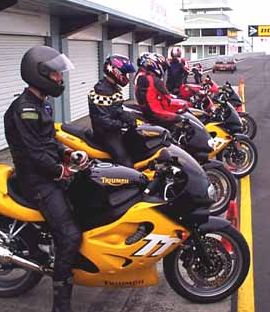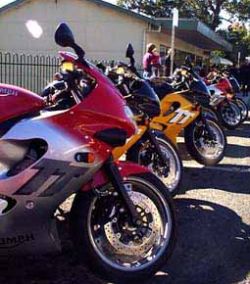Road tests
Triumph TT600 launch
May 18-19, 2000
 Triumph
has gone and thoroughly stuck its head into the hornets nest by releasing
the TT600 about four years after it first came up with the idea. This time
it is making no apologies for taking on the Japanese manufacturers at their
own game in what is probably the most hotly contested class - supersport
600s.
Triumph
has gone and thoroughly stuck its head into the hornets nest by releasing
the TT600 about four years after it first came up with the idea. This time
it is making no apologies for taking on the Japanese manufacturers at their
own game in what is probably the most hotly contested class - supersport
600s.
A quick scan of the specs panel and a walk around the bike reveal no
great surprises. The package hangs off an alloy frame with a four-cylinder,
liquid-cooled, fuel-injected powerplant, six-speed transmission and so
on.
The performance claims fall somewhere in the middle of the pack, with
170 kilos dry weight and 110 horses being claimed.
BEGGING A QUESTION
Why take on this class when Triumph was getting along quite nicely
with its 900cc-plus chaps? According to export manager Ross Clifford, the
600 class is a monster slice of the world market and simply couldn't be
ignored if the firm was serious about developing as a manufacturer.
That development is key to the plot. Producing a modest 25,000 bikes
per annum at the moment, Triumph is on a mission to become a manufacturer
that offers a full range of machinery.
Its reasoning is that a dealer will find it difficult to dedicate resources
to the brand until there is a complete line-up on offer. To that end, the
UK company says it will be launching two major new models per year for
the forseeable future.
Which begs a question: what's next? Well, there's been plenty of talk
of a big-bore Bonneville over recent months ...
FIRING UP
First impression of the TT is that it's among the taller bikes in this
class, with a comparatively upright seating position and overall presentation
that is reminiscent of the CBR600. Medium-height to tall people will love
it, as the ride position is roomy enough to cater for longer limbs. Shorter
folk may struggle - we suggest you check it out for size.
Firing up is the standard Triumph practice of pulling the clutch and
thumbing the starter - with no throttle. The powerplant has got a note
that is its own and is reluctant to wake up under 4000rpm. That last trait
can catch you out until you get used to the idea of keeping the engine
on the boil.
From 5000 to around 12,500 (redline is 14,000) there's a good, steady,
supply of power. Entirely predictable off the throttle, and enabling to
the rider to get on the power early on the way out of a turn.
The only exception is a 'step' in action from zero to a touch of throttle
that seems to be typical of current fuel injection systems. For some reason
the transition doesn't seem to be as smooth as with a conventional carb
set-up.
The transmission is easily Triumph's best so far, with a light and positive
action. If you get clumsy with the shift it will, if anything, refuse to
shift rather than leave you in a false neutral. Good stuff.
Suspension (by Kayaba) is very well sorted stock settings for the road,
with adjustment at both ends for preload, rebound and compression.
The TT proved surprisingly comfortable on some fairly snotty roads,
and stable at speed. Clifford reckons much of this is down to the factory's
efforts to minimise unsprung weight while providing better than average
suspension. No argument so far.
Braking up front is compliments of the four-pot stoppers off the T955,
working smaller and lighter discs for very good results. Up back there's
a single-pot disc set-up.
Instrumentation is what is now becoming the standard analogue tacho
and digital speedo/warning lamp/odometer cluster. While we're not fond
of digital speedos, Clifford suggested we might as well get used to them
as they represent a very significant weight saving for a machine of this
type.
There is a range of accessories available off the rack, including
pipes, paddock stand, pillion grab handle (which should be standard), pillion
seat cowl, luggage rack plus a range of soft luggage designed specifically
for the bike.
TRACK TIME
Over at Phillip Island, the bikes were first tried on road settings,
and then with the recommended track set-up that involved bumping up rebound
and compression at both ends. On road settings, the bikes started getting
wobbly and emotional under the extra stress after a few laps. However the
upped damping rates settled this down.
From there it would be a matter of sorting the overall set-up for personal
tastes. We noted that the TT600s being used by the Australian Superbike
School were running with the fork legs pulled up through the clamps by
around 10mm for a little extra front end grip.
Bridgestone 010 rubber in an updated compound is stock fitment and seems
to work well enough both on the road and track.
We also got a chance to play with the factory competition carbon muffler.
This is a straight swap for the stocker, with a new tuning map downloaded
to the bike from the factory diagnostic tool - all up a 20 minute job.
Triumph says the more open pipe adds a couple of horses.
The TT feels good on the track and road, providing more comfort than
we've come to expect from this class. Without comparing it side-by-side
with the likes of CBR, ZX, GSX-R and R6, we can say it's well and truly
in the ballpark.
Which is an impressive effort for a first-time stab at the class.
Launch price is $13,990 and it should do very nicely.
Brief specifications
Displacement: 599cc
Bore x stroke: 68 x 41.3mm
Compression ratio: 12.5:1
No. of cylinders: 4
Cooling: liquid
Max power: 110ps (82kW) at 12,750rpm
Max torque: 68Nm at 11,000rpm
Primary drive type: gear
Clutch type: wet
Clutch actuation: cable
Gears: 6
Final drive type: chain
Lubrication: wet sump
Oil capacity: 4.2 litres
Fuel capacity: 18 litres
Carburetion: sequential injection
Front/rear suspension type: Kayaba conventional fork/monoshock
Front/rear suspension travel: 120mm
Front/rear suspension adjustment: preload, compression, rebound
Front brakes: twin four-piston calipers on 310mm discs
Rear brake: single-piston caliper on 220mm disc
Front/rear tyre sizes: 120/70-17, 180/55--17
Frame type: twin-spar aluminium
Wheelbase: 1395mm
Seat height: 810mm
Castor: 24 degrees
Trail: 82mm
Dry weight: 170kg
Guy Allen
Further
Specifications and Images

[Roadtests | Motorcycle
Books]
![]()

![]()